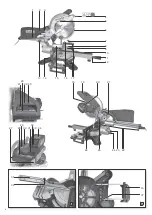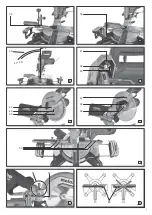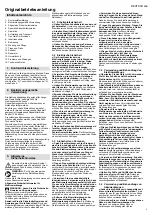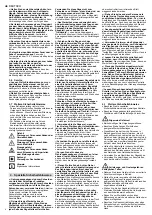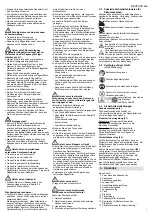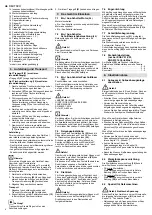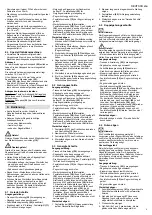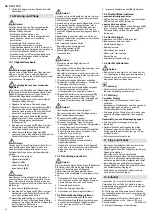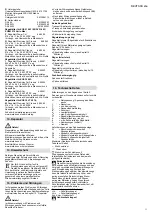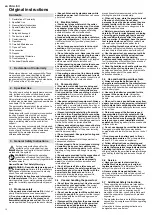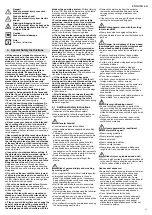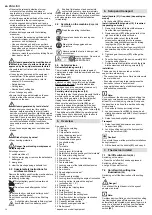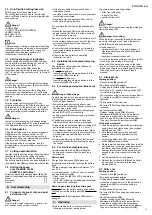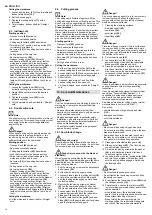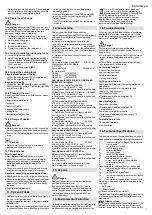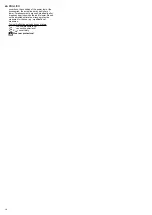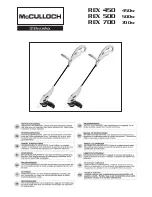
ENGLISH
en
12
Original instructions
1. Declaration of Conformity
2. Specified Use
3. General Safety Instructions
4. Special Safety Instructions
5. Overview
6. Setup and transport
7. The device in detail
8. Commissioning
9. Operation
10. Care And Maintenance
11. Tips and Tricks
12. Accessories
13. Repairs
14. Environmental Protection
15. Troubleshooting
16. Technical Specifications
We declare under our sole responsibility: These
crosscut and mitre saws, identified by type and
serial number *1), comply with all relevant
requirements of the directives *2) and standards
*3). Technical file at *4) - see page 4.
The mitre saw is suited for longitudinal and cross
cuts, inclined cuts, mitre cuts and double mitre
cuts. Furthermore grooves can be machined.
Only materials for which the respective saw blade
is suited may be machined (approved saw blades
see chapter 12. Accessories).
The permissible dimensions of the stock have to
be adhered to (see chapter 16. Technical
Specifications).
Workpieces with round or irregular cross-section
(such as firewood) must not be cut, as they
cannot be held securely during the cutting
process. When sawing a thin workpiece laid on its
edge, a suitable guide must be used for firm
support.
Any other use does not comply with the intended
purpose. Unspecified use, modification of the tool
or use of parts that have not been tested and
approved by the manufacturer can cause
unforeseeable damage!
For your own protection
and for the
protection of your electrical tool, pay
attention to all parts of the text that are
marked with this symbol!
WARNING
– Reading the operating
instructions will reduce the risk of injury.
Pass on your power tool only together with
these documents.
General Power Tool Safety Warnings
WARNING – Read all safety warnings and
all instructions.
Failure to follow all safety
warnings and instructions may result in electric
shock, fire and/or serious injury.
Keep all safety instructions and information
for future reference!
The term "power tool" in the
warnings refers to your mains-operated (corded)
power tool or battery-operated (cordless) power
tool.
3.1 Work area safety
a)
Keep work area clean and well lit.
Untidy or
poorly lit workplaces can cause accidents.
b)
Do not operate power tools in explosive
atmospheres, such as in the presence of
flammable liquids, gases or dust.
Power tools
create sparks which may ignite the dust or fumes.
c)
Keep children and bystanders away while
operating a power tool.
Distractions can cause
you to lose control.
3.2 Electrical safety
a)
Power tool plugs must match the outlet.
Never modify the plug in any way. Do not use
any adapter plugs with earthed or grounded
power tools.
Unmodified plugs and matching
outlets will reduce risk of electric shock.
b)
Avoid body contact with earthed or
grounded surfaces, such as pipes, radiators,
ranges and refrigerators.
There is an increased
risk of electric shock if your body is earthed or
grounded.
c)
Do not expose power tools to rain or wet
conditions.
Water entering a power tool will
increase the risk of electric shock.
d)
Do not abuse the cord. Never use the cord
for carrying, pulling or unplugging the power
tool. Keep cord away from heat, oil, sharp
edges or moving parts.
Damaged or entangled
cords increase the risk of electric shock.
e)
When operating a power tool outdoors, use
an extension cord suitable for outdoor use.
Use of a cord suitable for outdoor use reduces the
risk of electric shock.
f)
If operating a power tool in a damp location
is unavoidable, use a residual current circuit
breaker (RCCB).
Use of a residual current circuit
breaker reduces the risk of electric shock.
3.3 Personal safety
a)
Stay alert, watch what you are doing and
use common sense when operating a power
tool. Do not use a power tool while you are
tired or under the influence of drugs, alcohol
or medication.
A moment of inattention while
operating power tools may result in serious
personal injury.
b)
Use personal protective equipment. Always
wear eye protection.
Protective equipment such
as dust mask, non-skid safety shoes, hard hat, or
hearing protection used for appropriate conditions
will reduce personal injuries.
c)
Prevent unintentional starting. Ensure the
switch is in the off-position before connecting
to power source and/or battery pack, picking
up or carrying the tool.
Carrying power tools with
your finger on the switch or energising power tools
that have the switch on invites accidents.
d)
Remove any adjusting key or wrench before
turning the power tool on.
A wrench or a key left
attached to a rotating part of the power tool may
result in personal injury.
e)
Do not overreach. Keep proper footing and
balance at all times.
This enables better control of the power tool in
unexpected situations.
f)
Dress properly. Do not wear loose clothing
or jewellery. Keep your hair, clothing and
gloves away from moving parts.
Loose clothes,
jewellery or long hair can be caught in moving
parts.
g)
If devices are provided for the connection of
dust extraction and collection facilities,
ensure these are connected and properly
used.
U
se of dust extraction can reduce dust-
related hazards.
h)
Don't lull yourself into a false sense of
security and ignore the safety regulations for
power tools, even if you are familiar with the
power tool after frequent use.
Failure to
observe the following warnings can result in
serious injury or damage to property.
3.4 Use and handling the power tool
a)
Do not force the power tool. Use the correct
power tool for your application.
The correct
power tool will do the job better and safer at the
rate for which it was designed.
b)
Do not use the power tool if the switch does
not turn it on and off.
Any power tool that cannot
be controlled with the switch is dangerous and
must be repaired.
c)
Disconnect the plug from the power source
and/or the battery pack from the power tool
before making any adjustments, changing
accessories, or storing power tools.
Such
preventive safety measures reduce the risk of
starting the power tool accidentally.
d)
When not in use, store the power tools out
of the reach of children Do not allow
personnel to use the device unless they are
already familiar with it or have read these
instructions.
Power tools are dangerous in the
hands of untrained users.
e)
Maintain power tools and accessories
carefully. Check for misalignment or binding
of moving parts, breakage of parts and any
other condition that may affect the power
tool's operation. If damaged, have the power
tool repaired before use.
Many accidents are
caused by poorly maintained power tools.
f)
Keep cutting tools sharp and clean.
Properly
maintained cutting tools with sharp cutting edges
are less likely to bind and are easier to control.
g)
Use the power tool, accessories, tool bits
etc. in accordance with these instructions.
Take into consideration the working
conditions and tasks required.
Use of the power
tool for operations different from those intended
could result in a hazardous situation.
h)
Keep the handles and handle surfaces dry,
clean and free of oil and grease.
Slippery
handles and handle surfaces do not permit safe
handling and control of the power tool in
unforeseen situations.
3.5 Use and handling cordless tools
a)
Always charge the batteries only in
chargers recommended by the manufacturer.
Chargers designed for a specific type of battery
may pose a fire hazard when used together with
other battery types.
b)
Use only the batteries provided for this
purpose in the power tools.
Using other
batteries may cause injuries and pose a fire
hazard.
c)
When not in use, keep batteries away from
paper clips, coins, nails, screws or other small
metal objects that could bridge the contacts.
Short circuits between battery contacts can cause
burns or fires.
d)
Fluid may escape if batteries are used
inappropriately. Avoid all contact with this
fluid. In the event of accidental skin contact,
rinse the affected area thoroughly. If the fluid
enters your eyes, seek immediate medical
assistance.
Escaping battery fluid can cause skin
irritation or burns.
e)
Do not use damaged or modified batteries.
Damaged or modified batteries may behave
unpredictably and lead to fire, explosion or risk of
injury.
f)
Do not expose the battery pack to fire or
excessive temperatures.
Fire or temperatures
above 130 °C can cause an explosion.
g)
Follow all instructions on charging and
never charge the battery or the cordless tool
outside the temperature range indicated in the
operating instructions.
Incorrect charging or
charging outside the permitted temperature range
may destroy the battery and increase the risk of
fire.
3.6 Service
a)
Have your power tool serviced by a
qualified technician using only original
replacement parts.
This will ensure that the
safety of the power tool is maintained.
b)
Never service damaged batteries.
Any
servicing of batteries should only be carried out
by the manufacturer or authorised customer
service points.
3.7 Additional Safety Instructions
– These operating instructions are intended for
people with basic technical knowledge in
handling machines such as the one described
here. If you have had no experience with
machines of this kind, you should initially work
under the supervision of people with previous
experience.
– The manufacturer bears no liability for damage
caused by non-compliance with these operating
instructions.
Information in these operating instructions is
designated as shown below:
Contents
1. Declaration of Conformity
2. Specified Use
3. General Safety Instructions


